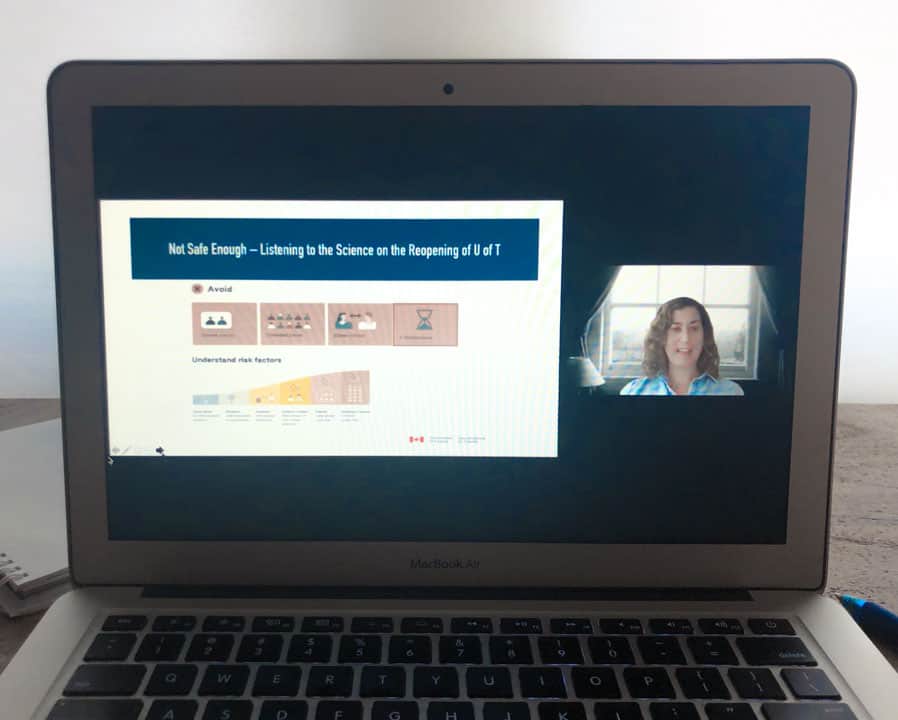On August 24, a coalition of the University of Toronto Faculty Association (UTFA) and five unions representing service workers, contract academic workers, and casual workers, organized an online panel to express safety and equity concerns about U of T’s reopening plan.
The panel’s speakers included professors, epidemiologists, and union leaders, and it was attended by over 250 people.
U of T’s plans are outdated, ignore airborne transmission
Amy Conwell, Chair of CUPE 3902 — the union that represents contract academic workers — started the call by outlining concerns that the plan is based on outdated science because it does not reflect emerging evidence of airborne transmission and neglects the role of symptomless transmission.
Echoing Conwell, Ashleigh Tuite, an assistant professor of epidemiology, said that since the outbreak, new data has emerged and there is much more nuanced scientific understanding of COVID-19. “Inhaling it by droplets or aerosols is really the major route of transmission,” explained Tuite, noting that the way COVID-19 most often transmits makes universities a high-risk setting.
Comparing opening university campuses to “dropping a cruise ship into the centre of a city,” Tuite said, “you again have these congregate settings where you have a large number of people existing within a relatively contained space.” She added that universities bringing back students is also a risk for the greater community.
Furthermore, according to Tuite, “being indoors is riskier than being outdoors, particularly in rooms that don’t have good ventilation.” Ventilation has been one of the unions’ biggest concerns, and they remain unconvinced that U of T has done what it says it has.
James Scott, Professor at the Dalla Lana School of Public Health (DLSPH), said that U of T’s administration sent a letter claiming that all ventilation systems “meet or exceed public health guidelines.” However, the UTFA has reached out to the administration for the assessment criteria and the buildings that were assessed, but it has not received a response with specific details.
“That’s really the information that we need in order to be able to understand well, first of all, if the claim is correct,” Scott added. He worries that the university “based its approach on the state of knowledge that we had in January and hasn’t adjusted its approach based on the growing body of much more informative science.”
When asked to grade U of T’s plan, epidemiologist David Fisman responded, “I’m going to give the school a weak ‘D’ grade because they did get hand sanitizer dispensers.”
Teaching assistants, equity concerns
A prominent concern for the panelists was the safety of teaching assistants (TAs). Kyle Shaw-Mueller, Vice Chair Unit 1 at CUPE 3902, outlined some of the difficulties they face. Not every TA has the choice to work online. Instead, individual campuses, faculties, and departments are left to make these decisions. While the university has an accommodation request process, it has not released a guarantee for TAs who want to work remotely.
Shaw-Mueller mentioned that he’s had conversations with multiple TAs who are worried about endangering immunocompromised family members. He added that “the best guarantee of safety is no in-person contact wherever possible. And TAs should have a right to refuse unsafe in-person work the same way instructors do.”
Arjumand Siddiqi, an associate professor at the DLSPH, outlined the disproportionate effects that the virus has on racialized people, most specifically, those who are Black and brown. She explained that racialized people often work jobs that don’t allow them to physically distance, such as caretakers or delivery people.
“It’s impossible to think about safe reopening plans without acknowledging that reopening has very different implications for different people.”
Lack of consultation
Another key concern during the panel was the lack of consultation between U of T administration and the unions when coming up with a COVID-19 plan. Scott added that experts at the DLSPH “provided feedback, mainly just to say, it needs more. And it disappeared into the void, and we didn’t really hear from them again.” He also described U of T’s plan as a “disorganized patchwork of 37 slide decks and spreadsheets.”
In addition, the plan is confidential and is only available to select groups of staff. According to Scott, a “real plan would have been developed in consultation with everyone, including our own experts. A real plan would have been based on science and a real plan would have been a consolidated document.”
He emphasized that an ideal plan would be “available to all members of our communities, not just a few selected members.”


